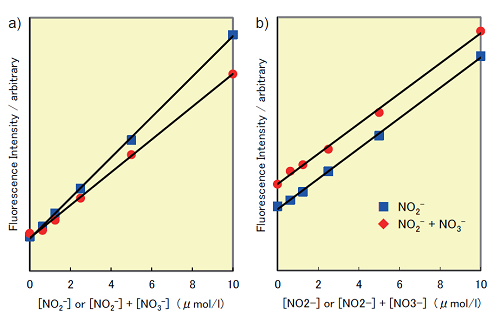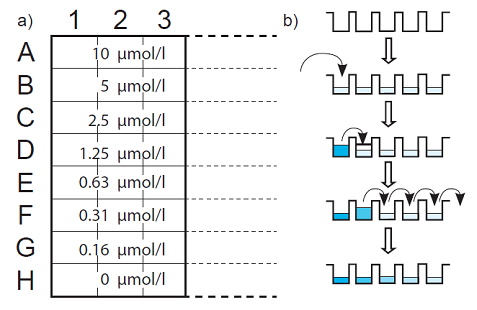General Information
Nitric oxide (NO), a gaseous paramagnetic radical, is a very important and versatile messenger in biological systems. NO is synthesized from L-arginine by NO synthase (NOS). It has been identified as an endothelial derived relaxation factor (EDRF) and antiplatelet substance. It serves as a neurotransmitter derived from a neutrophile and a cytotoxic substance from an activated macrophage. Although NO’s molecular action in the biological system is very versatile, the most important role of NO is the activation of guanylate cyclase.
The Griess assay is one of the most popular and simplest methods to detect the NO concentration. However, the sensitivity of Griess assay is sometimes not sufficient to determine μmol/l level of NO2-. 2,3-Diaminonaphthalene (DAN) reacts with NO2- and generates a fluorescent product as shown in Figure 1. Therefore, the fluorescence detection method using DAN can be used to determine the NO2- concentration more sensitively.
The reaction of 2,3-Diaminonaphthalene with NO2- proceeds under pH 2 at room temperature within 5 minutes,
and the fluorescence of produced naphthalenetriazole can be determined at pH10 or higher. The NO2/NO3 Assay Kit-FX contains 2,3-diaminonaphthalene, nitrate reductase, enzyme cofactor, buffer solution and NO2-, NO3- solutions as standard. Therefore, NO metabolites, NO2-- and NO3- , are easily detectable using this kit. The suitable detection range is from 1 to 10 μmol/l.
The excitation and emission maximum of naphthalenetriazole is 365 nm and 410-425 nm, respectively. However, in order to reduce the fluorescence blank of 2,3-diaminonaphthalene and increase the sensitivity of the
NO detection, the use of a 450-465 nm emission filter is recommended.

Figure 1. NO2- reaction with 2,3-Diaminonaphthalene
Contents of this kit
| Buffer Solution | x 1 |
| NaNO2 Standard Solution (200 μmol/l) | x 2 |
| NaNO3 Standard Solution (200 μmol/l) | x 2 |
| NO3 Reductase | x 2 |
| Enzyme Cofactors | x 2 |
| Fluorescence Reagent (DAN) Solution | x 1 |
| Stop Solution | x 1 |
Storage
Please store this kit at 0-5 oC. The reconstituted solutions of NO3 Reductase and Enzyme Cofactors should be stored at 0-5 oC, and be used up within 2 weeks. Do not freeze this kit and the reconstituted solutions.
Precaution
- This kit contains glass vials with an aluminium cap. Please handle carefully.
- Since inside of each vial of NO3 Reductase and the Enzyme Cofactors is under reduced pressure, add 1.2 ml Buffer Solution into the vial with a syringe in order to avoid the dispersal of the powder. Please do not open the rubber septum at the beginning.
Required Equipments and Materials
- Fluorescence microplate reader (excitation filter: 360-365 nm, emission filter: 450-465 nm)
- 96 well microplate (black plate or white plate)
- 10 μl, 100-200 μl pipettes, multi-channel pipette
Preparation of Reagent solutions
- 20 μmol/l NaNO2 Standard Solution : Add 9 ml of Buffer Solution ( or medium ) to a bottle of NaNO2 Standard Solution.
- 20 μmol/l NaNO3 Standard Solution : Add 9 ml of Buffer Solution ( or medium ) to a bottle of NaNO3 Standard Solution.
- NO3 Reductase Solution : Add 1.2 ml of Buffer Solution to a bottle of NO3 Reductase.
- Enzyme Cofactors Solution : Add 1.2 ml of Buffer Solution to a bottle of Enzyme Cofactors.
General protocol for 96-well micropalte assay
Preparation of NO2-- Standard Curve
- Dilute 80 μl of 20 μmol/l NaNO2 Standard Solution by serial dilution with 80 μl of Buffer Solution (or medium) in 96-well plate as indicated in Figure 2.
- Add 20 μl of Buffer Solution to each well (total volume is 100 μl/well).
- Add 10 μl of Fluorescence Reagent (DAN) Solution to each well, and mix. Then, leave the plate for 15 minutes at room temperature.
- Add 40 μl of Stop Solution to each well.
- Measure the fluorescence intensity of each well at 450-465 nm (excitation 360-365nm) with a fluorescence microplate reader.
- Add 80 μl of Buffer Solution to each well.
- Add 80 μl of 20 μmol/l NaNO2 standard Solution to A.
- Pipet well and transfer 80 μl to B.
- Repeat this step to G.
- Discard 80 μl from G.
Figure 2. A plate arrangement for preparation of a standard curve.
Preparation of NO2-+ NO3- Standard Curve
- Dilute 80 μl of 20 μmol/l NaNO3 Standard Solution by serial dilution with 80 μl of Buffer Solution (or medium) in 96-well plate as indicated in Figure 2.
- Add 10 μl of NO3 Reductase Solution and 10 μl of Enzyme Cofactors Solution to each well.
- Incubate the plate at 37 °C for 30 minutes.
- Add 10 μl of Fluorescence Reagent (DAN) Solution to each well, and mix. Then, leave the plate for 15 minutes at room temperature for complete reaction.
- Add 40 μl of Stop Solution to each well.
- Measure the fluorescence intensity of each well at 450-465 nm (excitation 360-365 nm) with a fluorescence microplate reader.

Figure 3. Standard curves of NO2-and NO2-+ NO3 - using NO2/NO3 Assay Kit-FX.
a) in Buffer Solution, b) in a medium (DMEM).
Preparation of Sample Solution
Cell or tissue culture medium:
Use phenol red free medium. Centrifuge the medium at 1,000 x g for 15 minutes, and use the supernatant as a sample solution. A cell culture medium that contains NO3- as a component (such as RPMI1640) cannot be used to detect NO3-. However, NO2- in the medium can be determined using this kit.
Serum:
Serum or plasma sample should be treated with Amicon Ultra-4 Centrifugal Filter Unit with Ultracel-10 membrane (7,000 x g, 4 oC, 20minutes) to remove hemoglobin and proteins.
Determination of NO2-Concentration in Sample Solution
- Add 80 μl of a sample solution to a well.
- Add 20 μl of Buffer Solution to each well.
- Add 10 μl of the Fluorescence Reagent (DAN) Solution to each well, and mix. Then, leave the plate for 15 minutes at room temperature for complete reaction.
- Add 40 μl of Stop Solution to each well.
- Measure the fluorescence intensity of each well at 450-465 nm (excitation 360-365 nm) with a fluorescence microplate reader.
- Determine the concentration of NO2- in the sample solution from the standard curve.
Determination of NO2-+ NO3 - Concentration in Sample Solution
- Add 80 μl of a sample solution to a well.
- Add 10 μl of the NO3 Reductase Solution and 10 μl of the Enzyme Cofactors Solution to each well.
- Incubate the plate at 37 oC for 30 minutes.
- Add 10 μl of the Fluorescence Reagent (DAN) Solution to each well, and mix. Then leave the plate for 15 minutes at room temperature for complete reaction.
- Add 40 μl of Stop Solution to each well.
- Measure the fluorescence intensity of each well at 450-465 nm (excitation 360-365 nm) with a fluorescence microplate reader.
- Determine the concentration of NO2-+ NO3 - in the sample solution using the standard curve.
Determination of NO3- Concentration in Sample Solution
NO3- concentration can be obtained by the following equation.
[NO3-] = [NO2-+ NO3 -] - [NO3-]
Notes
- The NO3 Reductase Solution and the Enzyme Cofactors Solution should be kept on an ice bath during the use. Please store these solutions at 0-5 oC. The solutions should be used up within 2 weeks.
- This kit can be used to determine NO3- and NO2- in the concentration range from 1 to 10 μmol/l. Dilute the sample solution if it contains high concentration of NO3- and NO2-. If the sample volume is less than 80 μl, add Buffer Solution to be the total volume of 80 μl.
- Do not mix the NO3 Reductase Solution and the Enzyme Cofactors Solution prior to use.
- NO3 Reductase and the Enzyme Cofactors are packaged under reduced pressure. Please open the caps with caution, or add solvent before opening.
- The Fluorescent Reagent (DAN) Solution is light sensitive. Please keep it in dark at all times.
- For fluorophotometric assay, dilute 100 μl of the solution, treated with Stop Solution at the final step with 3.9 ml of ddH2O, and measure the fluorescence intensity.
Frequently Asked Questions / Reference
NK08: NO2 /NO3 Assay Kit-FX(Fluorometric) -2,3-Diaminonaphthalene Kit-
Revised Dec., 05, 2023


 Hidden sections will not be printed.
Hidden sections will not be printed.


